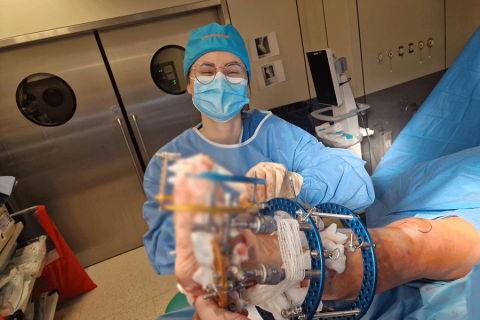On January 24 this year, a team from the Department of Orthopedics and Traumatology of the Locomotion System, headed by Paweł Łęgosz, MD, PhD, consisting of Radosław Górski, MD, PhD, Ryszard Górski, MD, PhD, and Aleksandra Sibilska, MD, performed two diabetic foot treatments. This would not have been possible had it not been for the cooperation with two departments of the UCC MUW. The cooperation concerns the treatment of the diabetic foot, and the mentioned departments are: Department of Diabetology and Internal Medicine, headed by Prof. Leszek Czupryniak, and the 2nd Department of Anesthesiology and Intensive Care, headed by Dr. Paweł Andruszkiewicz.
At our center, we have attempted to treat and supply bone deformities in the course of diabetes, as well as ulcers and soft tissue defects using the Ilizarov method - multi-tissue reconstructions using distraction histogenesis, as well as the possibility of tissue compression using external stabilization - says Paweł Łęgosz, MD, PhD. And he adds: we are also using other techniques from the field of orthopedic procedures that have not been used in the treatment of diabetic foot so far.
The subject of the diabetic foot in the Department of Orthopedics and Traumatology of the Locomotion System is dealt with by Dr. Radosław Górski and his team, who consult patients with deformities of the foot, ankle and lower leg arising against the background of “Diabetic Foot Syndrome,” which is a chronic complication of diabetes - now counted among the diseases of civilization.
The diabetology team is headed by Dr. Tomasz Głażewski, who prepares patients for orthopedic procedures, and actively treats wounds arising from the “Diabetic Foot Syndrome.” Patients treated by Dr. Głażewski's team are provided with professional, by Polish standards, care that gives them a chance to recovery.
The procedures could take place with the help of the anesthesiology team, led by Professor Paweł Andruszkiewicz. The anesthesia of patients with diabetic foot syndrome is a challenge associated with a number of internal medicine burdens, as well as the skills associated with regional anesthesia.
Dr. Izabela Kurek and her team of resident docotrs safely administered regional anesthesia, and in the case of reconstructive surgery, post-operative regional analgesia was implemented, ensuring the patient's comfort in changing dressings and conducting treatment with the Ilizarov method.
Thanks to this cooperation, patients can count on comprehensive, in many cases limb-sparing, treatment.
